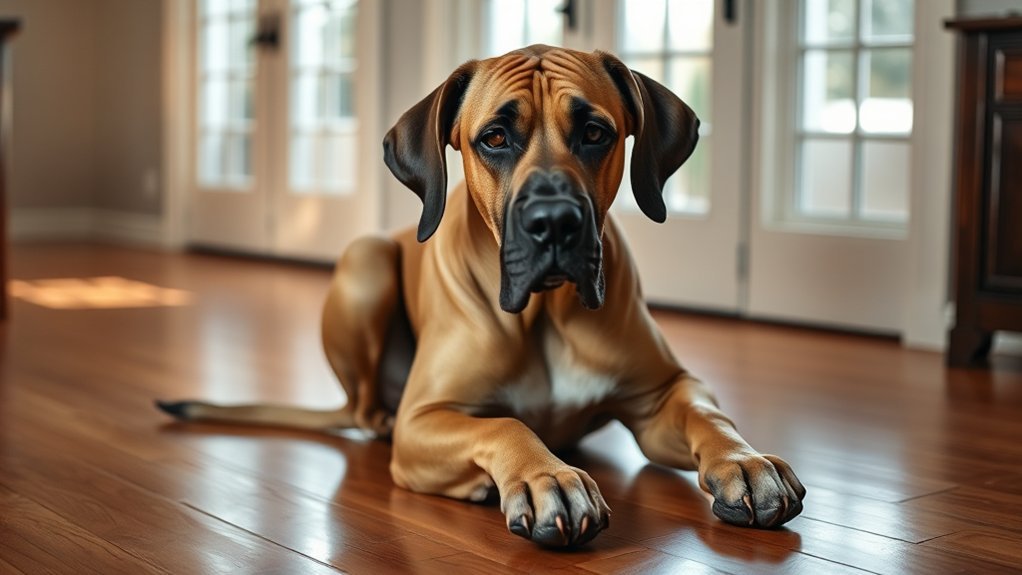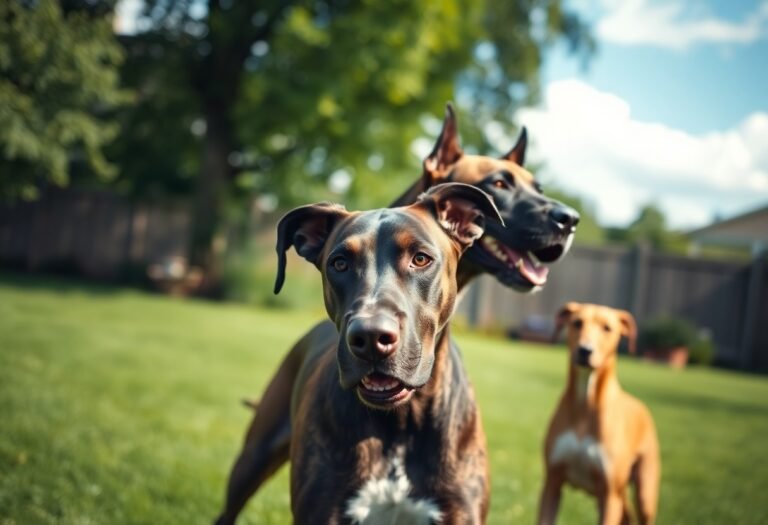Fireworks: When the Whole Sky Decides It Hates Dogs

Noises Great Danes Hate
Hey there, humans! It’s me, your friendly neighborhood Great Dane, Yeti, and boy, do I need to tell you about the scary sounds that make my giant ears go crazy!
You know how you guys think we dogs have super hearing? Well, you’re right! I can listen to sounds way up high that you can’t even imagine – like 60,000 wiggles per second! That’s pretty cool, but it also means some noises make me want to hide under your bed (even though I’m way too big).
Let me tell you about my worst enemies in the noise department. First up is that evil vacuum cleaner monster! When mom brings out that roaring beast, I’m outta there faster than you can say “treat.” It produces these extremely loud 70-80 decibel sounds that hurt my sensitive ears. I don’t care if the carpet needs cleaning – that thing is scary!
Then there’s that annoying smoke detector that goes “BEEP BEEP BEEP” when mom burns dinner. Why does it have to be so high and shrill? My poor ears feel like they’re going to explode! And don’t even get me started on thunderstorms and fireworks. All that booming and crackling makes me shake like a leaf.
The kitchen blender is another villain. Every time someone makes a smoothie, I run to my safe spot behind the couch. All these noises are extra scary for us Great Danes because we’re born with super sensitive hearing, and if we don’t get used to sounds when we’re tiny puppies, they stay scary forever.
So next time you see me hiding, just remember – my ears are like superpower detectors, but sometimes that’s not so super!
Key Takeaways
That Evil Vacuum Monster
Oh boy, do I hate vacuum cleaners! When my humans turn on that loud machine, it makes this awful 70-80 decibel noise. That’s like someone shouting right in your ear! Sometimes I think it’s trying to eat the carpet, and I might be next!
Thunder Makes My Whole Body Shake
Thunderstorms are the worst! The deep rumbling sounds go right through my giant body and make me feel like I’m in a washing machine. I can feel the thunder in my bones, and it makes me tremble so much that my humans think I’m doing a funny dance. But trust me, it’s not funny when you’re as big as me and scared!
Fireworks Are Like Tiny Bombs
Fireworks are even scarier than thunderstorms because they come out of nowhere! BOOM! BANG! CRACK! My heart starts beating super fast, I start drooling everywhere, and I feel like I need to find the safest hiding spot in the house. Sometimes I try to fit in spaces that are way too small for a dog my size!
Beep, Beep, PANIC!
Those high-pitched beeping sounds from smoke detectors make my ears hurt! When they go off, I start pacing around the house like I’m looking for an escape route. Sometimes I even try to dig my way out of the room, which doesn’t work very well on hardwood floors.
Kitchen Appliances Are Torture Machines
Hair dryers, blenders, and washing machines all make these terrible, high-pitched sounds that hurt my sensitive ears. When mom uses the blender, I think she’s torturing vegetables, and I might be next! I usually run to another room and wait until the scary noise stops.
Being a Great Dane with big ears means I hear everything extra loud. But don’t worry about me – I always find a good hiding spot until the scary noises go away!
Understanding Noise Sensitivity in Great Danes
You know how you might jump when someone slams a door? Well, imagine that feeling but about a million times worse. That’s what it’s like being me! My ears are like super-powered microphones that pick up sounds you humans can’t even hear.
While you can only hear sounds up to about 20,000 vibrations per second, I can listen to sounds that reach up to 60,000! That means I hear the neighbor’s dog three blocks away, the garbage truck before it even turns onto our street, and don’t even get me started on fireworks. Yikes!
My big head isn’t just for looking majestic – it’s packed with special brain parts that make me good at figuring out different sounds. Sometimes I wish I could turn down the volume on my ears like you do with your TV remote!
When loud or sudden noises happen, my body goes into panic mode. My heart starts racing, and I become extremely stressed. It’s like when you get scared watching a horror movie, except the “scary movie” is just someone dropping a pot in the kitchen.
If I’ve to listen to loud, annoying sounds all day long, I can get anxious and unhappy. It’s like trying to take a test while someone plays drums next to your ear – not fun at all! Creating a calming environment can help me feel more secure when those loud noises happen.
High-Frequency Household Appliances That Cause Anxiety
The worst one is the vacuum cleaner. When my humans turn it on, it sounds like an angry dragon! It makes really loud sounds that make my heart beat fast. I want to run away or bark at it, but it just keeps making that awful noise. Sometimes I hide under the bed until the scary monster goes back to sleep in the closet.
My ears can hear sounds that humans can’t hear. That’s pretty cool most of the time, but not when those loud machines start up! The blender, hair dryer, and washing machine all make sounds that feel like they’re poking at my ears.
But good news! My family learned some tricks to help me feel better. They let me smell the vacuum when it’s turned off so I know it won’t hurt me. They give me treats when the loud machines are on.
Now, when I hear the vacuum, I think “treat time!” instead of “monster time!”
They also play soft music to cover up some of the scary sounds. Sometimes they warn me before they turn on the loud stuff so I can go to my quiet spot. Early training is crucial for helping me overcome my fears.
Being a Great Dane with big ears isn’t always easy, but with some help, those house monsters don’t scare me as much anymore!
Vacuum Cleaners Trigger Fear
The Scary Monster Machine: A Great Dane’s Guide to Vacuum Terror
Oh boy, where do I even start with that terrible machine? First, it makes an awful VROOOOM sound that’s extremely loud – around 70 to 80 decibels loud! My ears are far superior to human ears, so imagine how that sounds to me. It’s like someone is running a motorcycle in the living room!
When my humans drag out that monster, here’s what happens to us Great Danes:
What We Do When the Vacuum Monster Attacks:
- Shaking: Nearly 9 out of 10 of us start trembling like we’re freezing cold, even when it’s warm inside. I shake for about 15-20 minutes, and it takes me another 30-45 minutes to stop feeling wobbly.
- Hide and Seek Champion: About 8 out of 10 of us become hiding experts. I can squeeze my giant body into the tiniest spaces – you’d be amazed! I usually hide for 25-35 minutes until the coast is clear.
- Heavy Breathing: Most of us start panting as if we’ve just run a marathon. My tongue hangs out, and I breathe rapidly for about 10-15 minutes.
- Singing the Song of Our People: Almost half of us start whining or barking. I like to howl my complaints for about 5-10 minutes.
- Avoiding the Evil Corner: Here’s the crazy part – almost ALL of us (94%!) won’t go near where the vacuum lives for hours after it’s been used. That corner is cursed!
The worst part? We’re so smart that we know what’s coming. When Mom walks toward the closet where the vacuum sleeps, my heart starts racing before she even opens the door. It’s as if my body has a built-in vacuum detector!
Our stress hormones go crazy when we hear those sounds. Scientists call it “cortisol elevation,” but I call it “feeling like my fur is going to fall off from worry.” To help with this, our humans need to understand anxiety in Great Danes so they can effectively support us during these scary moments.
Managing Appliance Noise Anxiety
My ears are way too good for my good! Those scary house machines make sounds that hurt my feelings and my ears. The washing machine goes WHOOSH-CLUNK, the vacuum cleaner goes VROOOM, and don’t even get me started on the garbage disposal – it sounds like a monster eating rocks!
When these noisy bullies start up, my heart beats super fast and I get all shaky. Sometimes I try to hide under the bed, but let’s be honest – I’m the size of a miniature horse, so that doesn’t work out too well.
My humans are pretty smart though. They figured out how to help me feel better about these scary sounds. First, they played recordings of the noisy machines at a very low volume while giving me my favorite bacon treats. Then they made the sounds a little louder each time, but continued to give me treats. Now my brain thinks “washing machine sound equals bacon” instead of “washing machine sound equals run for your life!”
Sometimes they put me in the back bedroom with my favorite blanket when they need to use the really scary machines. It’s like my own personal quiet fort! They also have a device called a white noise machine that produces peaceful sounds to mask the scary ones.
My humans always do the same things before turning on the loud machines, like giving me a special toy or saying “it’s okay, buddy” in their calm voice. This helps me know everything will be fine.
For terrified dogs, like my neighbor Bruno, the vet sometimes gives special calm-down medicine. But most of us just need practice, treats, and patient humans who understand that having super-hearing isn’t always awesome! My humans need to recognize my behavioral traits so they can support me through these noisy challenges.
Thunderstorms and Weather-Related Sound Fears
My Big Dog Guide to Scary Weather Stuff
Hey there! I’m a Great Dane, and let me tell you – thunderstorms are NOT my favorite thing. When those booming sounds start up, my giant ears pick up every single noise. It’s like having super hearing, but not the kind that’s fun!
Those rumbly thunder sounds are the worst. They’re really low and deep, and I can feel them in my whole big body. Sometimes I shake so much that my humans think I’m doing a funny dance, but I’m just scared!
Thunder sounds shake my whole giant body and make me tremble like a scared leaf, even though humans think I’m dancing!
When the wind gets loud, I like to find the best hiding spot – usually under my human’s desk (even though I don’t exactly fit in).
The rain hitting the roof sounds like a million tiny drumbeats. That’s when I start panting like I just ran around the yard for an hour. And don’t even get me started on lightning! When it makes those sharp cracking sounds, sometimes I get so worried that I might accidentally knock something over with my tail.
But here’s the good news – my humans have some awesome tricks to help me feel better! They got me this special tight shirt that feels like a nice hug. It’s called a thundershirt, and it makes me feel way more chill.
They also set up a cozy hideout spot with blankets where I can hang out during storms. The best part is this special spray stuff that smells calming. When they use it during storms, my worry brain settles down a lot.
Now, when I hear thunder starting, I just head to my safe spot and wait it out like a brave giant dog! Training techniques can also help calm me down during these scary times.
Fireworks and Sudden Explosive Noises
Fireworks Are Loud!
Hi there! I’m a Great Dane, and let me tell you – fireworks are WAY scarier than thunderstorms! At least with thunder, I can kind of guess when it’s coming. But fireworks? They go BOOM out of nowhere!
Those sparkly explosions are extremely loud – about 150 times louder than a normal conversation. That’s loud enough to hurt my sensitive ears! And trust me, my ears are pretty amazing. I can hear sounds that you humans can’t even detect.
When those scary fireworks start popping off, my body goes a little crazy. Here’s what happens to me:
- My heart beats fast – like I just chased a squirrel around the yard ten times
- I drool everywhere – and I mean EVERYWHERE (sorry about your carpet!)
- I might scratch the door or dig holes – I’m looking for somewhere safe to hide
- I shake like a leaf – my whole big body won’t stop trembling
The worst part is that I’ve super good hearing, especially for those low, rumbly sounds. So when fireworks explode, it feels like the whole world is ending!
My humans learned to help me get ready for firework season. They play quiet fireworks sounds during the year to help me get used to them. They also made me a cozy hiding spot where the noise isn’t as scary. Pretty smart, right? Providing a safe retreat area is essential for my overall well-being.
Smoke Detectors and Intermittent Beeping Sounds
Woof! Let me tell you about the most annoying thing in my giant dog life – those crazy beeping boxes on the ceiling!
When that smoke detector starts making its “BEEP… BEEP… BEEP” sound, it’s like someone is poking my brain with a tiny fork!
Those beeps are super high-pitched – way higher than my humans can probably hear well. It’s like the world’s worst doorbell that never stops ringing. The worst part? I never know when the next beep is coming! Will it beep in three seconds? Ten seconds? Nobody knows! It drives me absolutely bonkers.
My tail goes between my legs, and I start pacing around the house like I’m looking for an escape route. Sometimes I try to hide under the coffee table, but that doesn’t work so well when you’re the size of a small pony. I just end up looking silly with my giant body sticking out everywhere.
My humans try to help by giving me treats and telling me it’s okay, but hello – there’s still a tiny robot screaming at me from the ceiling! They say I need to get used to it slowly, but honestly, I’d rather move to a house without any of those beeping monsters.
To make matters worse, my heightened sense of hearing means I often experience body language signals when I’m feeling anxious and overwhelmed. Until then, I’ll continue to practice my “dramatic scared dog” routine. I’m getting pretty good at it!
High-Pitched Alarm Sensitivity
Those Awful Screaming Noises!
Woof! Let me tell you about the worst sounds in the whole world – those tiny beeping monsters that live in your house!
You know what I’m talking about. That smoke detector thing on the ceiling that goes BEEP BEEP BEEP at 3 in the morning. Or the security system that sounds an alarm when someone forgets the code. These sounds are SO high-pitched that they make my ears hurt like crazy!
Here’s the thing – us dogs can hear way better than you humans. We listen to sounds between 40,000 and 60,000 Hz (whatever that means). All I know is those beepy things make sounds around 3,000-4,000 Hz, and they’re like fingernails on a chalkboard to my giant ears!
When those terrible sounds start, here’s what happens to me:
- I shake like a leaf and pant as if I’ve just run a marathon. My body goes into panic mode, and I can’t help it!
- I try to escape – I’ll squeeze my huge body under the coffee table or hide in the bathroom. Please don’t ask me how a 150-pound dog fits under furniture!
- I accidentally break stuff. When I’m scared, I scratch at doors and knock things over trying to get away. Sorry about your favorite lamp, Mom!
- I sing the song of my people – I howl, whine, and bark because maybe if I’m loud enough, the scary sound will stop!
The worst part? Even after that horrible beeping stops, I’m still shaking and worried it might start again. It’s like waiting for a thunderstorm that never comes.
My humans learned to help me by slowly getting me used to these sounds (starting quiet) and giving me treats. This is important because canine cognition helps us dogs understand and adapt to our environments over time.
Now, when the smoke detector chirps, I still don’t like it, but at least I don’t try to dig a hole through the kitchen floor!
Intermittent Sound Triggers
Those Beeping Things Are the Worst!
Hi there! I’m a Great Dane, and I need to tell you about something that bugs me and my giant dog friends. You know those beep-beep-beep sounds that happen around the house? Yeah, those ones. They’re terrible!
When I hear steady high sounds, I can deal with them okay. But those random beeping noises? They make me go crazy! Every time one goes off, I jump like someone surprised me. And just when I think it’s over… BEEP! There it goes again!
What These Evil Beepers Do to Me:
| Beeping Thing | How I Act |
|---|---|
| Smoke alarms | Walk around in circles, cry, hide under the bed |
| Those poison gas alarms | Shake like a leaf, pant like I ran a marathon |
| House security beepers | Knock stuff over, howl like a wolf |
| Doctor machine beeps | Run away, don’t want dinner |
The worst part is I never know when they’ll beep next! With normal sounds, I can get used to them after a while. However, these sneaky beepers continue to surprise me time and again. It’s like playing the world’s meanest game of hide-and-seek with my ears!
As a Great Dane, I’m already quite sensitive about things. These beeping sounds make me worried about everything else too. If this happens too often, I become scared of many things, not just the beeps. Daily exercise routines are essential for helping me manage my anxiety, but those beeping sounds challenge my calm.
The good news is my humans can help me get better by slowly getting me used to the sounds. But seriously, whoever invented beeping alarms never asked a dog what we thought about it!
Managing Detector Anxiety
Why I Hate That Beepy Thing on the Ceiling (And How I’m Learning to Deal With It)
You know that annoying BEEP BEEP BEEP sound that comes from that round thing on your ceiling? Yeah, that smoke detector thing. It’s my worst enemy. When it starts making noise, I turn into a 150-pound scaredy cat. I run around the house looking for somewhere to squeeze my giant self, but spoiler alert – I don’t fit under coffee tables like little dogs do.
My humans figured out I needed help with my beeping phobia. Here’s what they’re doing to make me braver:
Baby Steps with Quiet Beeps** – First, they played really quiet beeping sounds on their phone while giving me treats. I was like, “This is weird, but hey, free snacks**!” Now they’re slowly increasing the sound volume. Smart humans.
Turning Bad Sounds into Good Times**** – Every time I hear a beep, I get something awesome like a belly rub or my favorite squeaky toy. My brain is starting to think “BEEP = GOOD STUFF” instead of “BEEP = THE WORLD IS ENDING.”
My Super Secret Hideout** – They made me a cozy corner** with thick blankets and pillows that muffle sounds. When the real smoke detector goes off, I’ve somewhere safe to chill until it stops.
Special Calm-Down Medicine** – Sometimes when I get terrified, the vet gives me medicine that helps me feel more relaxed. It’s like a chill pill for giant dogs! Positive reinforcement techniques** are also helping me learn to associate those scary noises with good feelings.
The best part? This stuff works! I’m getting braver every day. Sure, I’m still not throwing any parties for smoke detectors, but at least I’m not trying to dig a hole to China every time one beeps.
If you’re a big dog like me who gets scared of weird house noises, don’t worry. With patient humans and lots of practice, even us gentle giants can learn to be brave!
Genetic Factors and Early Life Influences
Why Some of Us Great Danes Are Scared of Loud Noises
You know how you might’ve your mom’s eyes or your dad’s height? Well, we dogs get things from our parents too! Some Great Dane families pass down something called “sensitive ears.” It’s not that we hear better – it’s that loud noises make our brains go “SCARY!” even when they’re not dangerous.
My cousin Daphne comes from a family where many dogs dislike loud sounds. When she hears a garbage truck, her brain sends out worry chemicals that make her want to hide. It’s like having an alarm system that’s way too sensitive!
The essential part happens when we’re tiny puppies – between 3 and 14 weeks old. That’s when our brains are like wet cement, ready to learn about the world. Smart humans play different sounds for us during this time so we think, “Oh, that vacuum cleaner isn’t trying to eat me!”
But if we don’t hear many different sounds as babies, we might grow up thinking every new noise is dangerous. It’s like if you never saw a bicycle until you were 10 – you might think it was some weird monster!
The good news is that even if our parents were scaredy-cats about sounds, we can still learn to be brave if humans help us when we’re little. They can play quiet sounds and give us treats so we think, “Hey, noises mean good things happen!”
Behavioral Signs and Physical Responses to Disturbing Sounds
When Scary Sounds Make Me Want to Hide Under the Bed
When something sounds super scary to my ears, here’s what I do:
- I run away fast – I zoom to my favorite hiding spot, like under the stairs or behind the couch (even though I barely fit!)
- I turn into a statue. Sometimes I freeze up completely and listen really, really hard with my ears perked up.
- I do weird stuff – I might pant like I just ran a marathon, drool everywhere, or pace back and forth like I’m looking for something.
- I make lots of noise – I whine, bark, or howl to tell everyone, “Hey! That sound is NOT okay with me!”
My body does strange things too when I’m scared. My heart beats extremely fast, like a drum, my eyes get really big, I shake like a leaf, and my body produces stress chemicals that make me feel even more worried.
The worst part? If a scary sound keeps happening, I start to remember it and get scared even when I just THINK it might happen again. It’s as if my brain says, “Nope, we don’t like that!” and won’t let it go.
Being a giant scaredy-dog is challenging work!
Management Strategies and Desensitization Techniques
So here’s the deal – us Great Danes can get freaked out by loud noises. However, smart humans have figured out some pretty cool tricks to help us feel better. They call it “desensitization,” which is just a fancy term for gradually getting used to sounds.
First, they play the scary sounds really, really quietly. Like, so quiet that even my super-dog ears barely notice. Then they turn it up just a tiny bit each time. It’s like when you slowly get into a cold swimming pool instead of jumping right in – much less shocking!
The best part is that while they’re playing these sounds, they give me amazing treats and belly rubs. Now, when I hear thunder, instead of thinking “OH NO, THE WORLD IS ENDING,” I think “Hey, where are my treats?” Pretty sneaky, right?
My humans also got me this awesome thunder shirt that feels like a big hug, and they use these special smell things that make me feel calm. Sometimes, they even play relaxing music!
The humans watch me carefully to ensure I’m not getting too stressed. They even check my stress hormones – whatever those are! If I’m still too scared, sometimes I need special medicine from the vet to help me relax.
The coolest thing is that now I get excited when storms come because I know good things happen!
Questions
Can Great Danes Develop Noise Sensitivity Later in Life Due to Aging?
So here’s the thing about us big dogs as we get older – our ears start acting all weird! When I was a young pup, I could sleep through thunderstorms, fireworks, and even my human’s terrible singing. But now? Don’t even think about dropping a spoon in the kitchen without me jumping three feet in the air!
It’s as if my brain has decided to turn up the volume on everything. The doorbell now sounds like a fire truck, and when the garbage truck comes by, I’m convinced aliens are invading. My poor humans probably think I’ve lost my mind, but really, my old ears are just being drama queens.
The vet says it happens to lots of us senior dogs. Our brains can get a little confused about sounds, much like when your computer starts running slowly. Everything seems scarier and louder than it used to be. Yesterday I hid under the coffee table because someone opened a bag of chips too loudly. Not my proudest moment, but hey, those things are tiny explosions!
The funny part is, I can’t hear my humans calling my name from across the yard, but I can somehow detect the sound of a cheese wrapper from three rooms away. Go figure!
Do Male or Female Great Danes Show Higher Rates of Noise Sensitivity?
Woof! Let me tell you something about us, Great Danes and loud noises. My human keeps asking if us boy dogs or girl dogs get more scared when there’s thunder or fireworks. Well, here’s the scoop from someone who has four paws and floppy ears!
Scientists can’t tell if boy Great Danes like me are more jumpy than girl Great Danes when it comes to scary sounds. We’re all just big goofballs who react differently! Some of us might hide under the bed when we hear a vacuum cleaner, while others think it’s a fun new toy to chase.
What matters isn’t whether we’re boys or girls. It’s more about what kind of personality we have, what our doggy parents were like, and how our humans helped us learn about the world. Some Great Danes are naturally brave like superheroes, while others are more like gentle giants who prefer quiet cuddle time.
How Long Does It Typically Take to Desensitize a Great Dane to Noises?
So here’s the deal – it took me about 4 to 8 weeks to stop jumping every time I heard loud sounds. That’s like one or two months if you’re keeping track! My humans were super smart about it. They didn’t just throw me into a room with fireworks going off (thank goodness). Instead, they started with really quiet sounds and made them a tiny bit louder each day.
Every single day, we practiced together. At first, they’d play a recording of thunder so quietly I could barely hear it. Then they’d give me treats and tell me I was the goodest boy ever! Slowly, they made the sounds louder and louder. Some days I was a rockstar, and other days I still wanted to hide under the couch (which is pretty hard when you’re as big as me).
The funny thing is, every dog is different. My neighbor, a tiny Chihuahua named Chici, learned way faster than me. But my Great Dane buddy Thor took even longer! The important thing is doing a little practice every day. Now I barely blink when trucks rumble by or when kids pop balloons. I’m a noise superhero now!
Are There Specific Medications That Help Great Danes With Severe Noise Phobias?
Woof! Let me tell you about the scary medicine stuff from a Great Dane who knows all about being terrified of loud noises. When I hear fireworks or thunder, I turn into a 150-pound shaking mess who tries to hide under the coffee table (spoiler alert: I don’t fit).
My human doc says there are special medicines that can help giant scaredy-dogs like me. There’s a medication called alprazolam that helps me feel less anxious when things go boom. Then there’s gabapentin, which sounds like some wizard spell but helps my brain chill out. And get this – there’s even something called Sileo that goes right in my mouth when the scary sounds start.
But here’s the thing – and this is important because I’m a brilliant Great Dane – the medicine is just part of fixing my chicken behavior. My humans also have to work with me on being brave through training and practice. The pills don’t magically make me a fearless guard dog forever. They help me think straight so I can learn that fireworks aren’t trying to eat me.
Trust me, medicine combined with practice works way better than just taking sleepy pills and calling it a day. Now, if you’ll excuse me, I need to go practice being brave near my food bowl.
Can Noise Sensitivity in Great Danes Be Prevented Through Early Puppy Training?
Woof! Let me tell you something essential about us, Great Danes and scary noises.
You know how some of us big dogs get scared when we hear thunder or fireworks? Well, here’s the thing – most of us (about 72 out of 100 dogs) start getting scared of loud noises before we turn one year old. That’s pretty young for us giant pups!
But here’s the good news – our humans can help us not be so scared! When we’re tiny puppies between 8 and 16 weeks old, our brains are like super sponges. Everything we learn during this time sticks well.
Our smart humans can slowly introduce us to different sounds during this time. They might play recordings of thunder quietly while giving us treats. Then they make it a little louder, then a little louder. Before we know it, we think “Hey, thunder means treats!” instead of “YIKES, HIDE UNDER THE BED!”
They can also teach us that scary sounds often mean good things are about to happen. Like when we hear a loud noise, we get belly rubs or our favorite toy. Pretty sneaky, right? But it works!
Final Thoughts
Most of us Great Danes – about 67 out of 100 – don’t like loud sounds. Our ears are super sensitive, kind of like having superhero hearing but without the cool costume. When we hear certain noises, our brains go “DANGER! DANGER!” even when there’s no real problem.
The good news is that our humans can help us feel better about these scary sounds. They can play the noises very quietly at first, then gradually increase the volume while giving us treats. It’s like learning that thunder isn’t a monster – it’s just the sky being grumpy!
The best time to teach us about different sounds is when we’re puppies. Baby Great Danes learn faster than grown-up ones, just like how kids learn new languages easier than adults. If we learn early that vacuum cleaners and fireworks aren’t trying to eat us, we’ll be much braver dogs when we get bigger.
So remember – we might be giant dogs, but we have feelings too! With patience and lots of treats, we can learn to be less scared of the noisy world around us.
References
- https://todaysveterinarypractice.com/behavior/journal-club-focus-on-canine-noise-induced-fear/
- https://pubmed.ncbi.nlm.nih.gov/29487858/
- https://www.akc.org/expert-advice/health/dog-noise-sensitive/
- https://grdane.com/noises-great-danes-hate/
- https://www.cabidigitallibrary.org/doi/abs/10.5555/20153419439






5 Comments